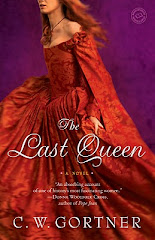I'm delighted to welcome back Jeri Westerson, author of the Crispin Guest historical noir series. Jeri has received resounding acclaim for her novels; set in 14th century London, her hero, Crispin, is a disgraced knight turned detective, trying to eke out a living while seeking to restore his fortunes. Jeri's stories are full of hard-hitting action and characters
with secrets. And there’s the added twist of murder and a relic with mystical powers that always seem to stir things up. In celebration of the release of BLOOD LANCE, the fifth installment in the series, Jeri offers us this guest post about that most iconic of London's attractions: The Bridge.
_by_Claes_Van_Visscher.jpg) But a bridge was eventually constructed many times over that
same spot for many hundreds of years, well after the Romans left. In Roman
times, it probably started off life as a simple wooden bridge. But as Britannia
became more important to the empire and as more commerce came through
Londinium, a grander wooden bridge was probably erected. Empires fell and
England began its many fights for power of the realm. The bridge fell into
disrepair and only built up again in order to move troops when the Saxons
wanted to assert power. When William the Conqueror arrived in 1066, he rebuilt
the bridge yet again, but in 1091, a freak tornado destroyed it. It was once
again rebuilt by his son William II but it was again destroyed in 1136, this
time by fire, and rebuilt in the mid-twelfth century. Under King Henry II in the
latter part of the twelfth century, a monastic guild, the "Brethren of the
Bridge", was created to oversee all work on the bridge, and in 1163 the
last timber bridge was built. It was in stone ever after that and that made all
the difference to commerce for the city.
But a bridge was eventually constructed many times over that
same spot for many hundreds of years, well after the Romans left. In Roman
times, it probably started off life as a simple wooden bridge. But as Britannia
became more important to the empire and as more commerce came through
Londinium, a grander wooden bridge was probably erected. Empires fell and
England began its many fights for power of the realm. The bridge fell into
disrepair and only built up again in order to move troops when the Saxons
wanted to assert power. When William the Conqueror arrived in 1066, he rebuilt
the bridge yet again, but in 1091, a freak tornado destroyed it. It was once
again rebuilt by his son William II but it was again destroyed in 1136, this
time by fire, and rebuilt in the mid-twelfth century. Under King Henry II in the
latter part of the twelfth century, a monastic guild, the "Brethren of the
Bridge", was created to oversee all work on the bridge, and in 1163 the
last timber bridge was built. It was in stone ever after that and that made all
the difference to commerce for the city.
London Bridge
By Jeri Westerson
What do you think of when you hear the words “London
Bridge”? Do you hear the nursery rhyme? You know the one:
London Bridge is falling down,
Falling down, falling down.
London Bridge is falling down,
My fair lady.
The origins of nursery rhymes are hard to trace and this one
is no different. It is likely from a seventeenth century rhyme incorporated
with an arch game people played in the Middle Ages, where participants join
hands to form an arch with folks dancing under it. At an appropriate part of
the rhyme or song, someone is trapped, like musical chairs without the chairs.
No matter the origins, London Bridge itself has been an
important part of London’s landscape for almost 2,000 years. The Romans built a
bridge across the river Thames where the embankments on both sides of the river
were high, and where the indigenous people probably forded the river when the
tide was low far before a bridge was ever built.
_by_Claes_Van_Visscher.jpg) But a bridge was eventually constructed many times over that
same spot for many hundreds of years, well after the Romans left. In Roman
times, it probably started off life as a simple wooden bridge. But as Britannia
became more important to the empire and as more commerce came through
Londinium, a grander wooden bridge was probably erected. Empires fell and
England began its many fights for power of the realm. The bridge fell into
disrepair and only built up again in order to move troops when the Saxons
wanted to assert power. When William the Conqueror arrived in 1066, he rebuilt
the bridge yet again, but in 1091, a freak tornado destroyed it. It was once
again rebuilt by his son William II but it was again destroyed in 1136, this
time by fire, and rebuilt in the mid-twelfth century. Under King Henry II in the
latter part of the twelfth century, a monastic guild, the "Brethren of the
Bridge", was created to oversee all work on the bridge, and in 1163 the
last timber bridge was built. It was in stone ever after that and that made all
the difference to commerce for the city.
But a bridge was eventually constructed many times over that
same spot for many hundreds of years, well after the Romans left. In Roman
times, it probably started off life as a simple wooden bridge. But as Britannia
became more important to the empire and as more commerce came through
Londinium, a grander wooden bridge was probably erected. Empires fell and
England began its many fights for power of the realm. The bridge fell into
disrepair and only built up again in order to move troops when the Saxons
wanted to assert power. When William the Conqueror arrived in 1066, he rebuilt
the bridge yet again, but in 1091, a freak tornado destroyed it. It was once
again rebuilt by his son William II but it was again destroyed in 1136, this
time by fire, and rebuilt in the mid-twelfth century. Under King Henry II in the
latter part of the twelfth century, a monastic guild, the "Brethren of the
Bridge", was created to oversee all work on the bridge, and in 1163 the
last timber bridge was built. It was in stone ever after that and that made all
the difference to commerce for the city.
London was always an important center and capital, and it
now had a bridge to match it. London Bridge joined the north bank (where anyone
who is anyone lived and worked) with the south bank, or Southwark (where
brothels and some of the poorer neighborhoods dwelt. Eventually, in
Shakespeare’s day, it was also the side where the theatres were erected, since
actors were thought of little better than whores.)
Meanwhile, London’s Bridge—and incidentally, its only
bridge—became more and more grand. And you had to pay a toll to cross. Either
you paid the Bridge’s toll or you paid a ferryman to ferry you across in a
boat. It might be more convenient and more covert to hire a ferryman in the
dead of night, particularly if you were up to no good, but the Bridge was
mostly the way to go.
Because London was so bustling, space was at a premium. It
was tough to expand outward as much of the land surrounding the formerly walled
city was pasture and belonged to others, and so they built upward, medieval
skyscrapers, if you will, reaching two and sometimes three storeys high
situated in crowded canyon-like streets and alleys. And the bridge was not
immune to this building. Houses, shops, and even a chapel were erected on the
bridge itself, cantilevering its structures over the churning Thames, going two
and three storeys high.
When I set out to write my latest Crispin Guest Medieval
Noir novel, BLOOD LANCE, I wanted to focus on London Bridge. It was its own
city within a city, and in fact, was its own parish. Much of the action takes
place on the bridge, including a climactic joust, which was based on real
jousts that were held there. London Bridge, with its closed-knit community,
suspicious of outsiders, seemed the perfect setting for a murder, and what
better murder than a man hurtling into the chilling Thames below? Consequently,
the Bridge becomes another character in the story, a stoic parade of stone
arches with buildings huddled on its shoulders, fearful of interlopers, and a
silent witness to murder.
Thank you, Jeri. Best of luck with the new novel.You can read more
about BLOOD LANCE and the other books in Jeri’s series, see discussion guides and read Crispin’s blog at Jeri's website.














No comments:
Post a Comment